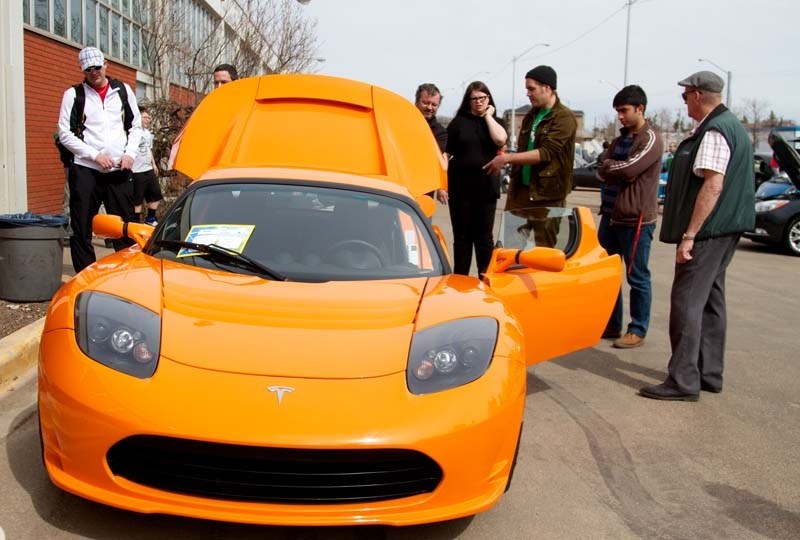Developers need to build the iPad of electric cars if those cars are to be the future of transportation, says the head of Alberta’s eco-rebate program.
Simon Knight, president of C3 (the provincial group that runs Alberta’s energy rebate programs), was one of a large number of speakers in Edmonton last Saturday for the third annual Future of Transportation Symposium and Car Show.
Organized by the Solar Energy Society of Alberta and the Northern Alberta Institute of Technology (NAIT), the free conference drew hundreds of car and renewable energy enthusiasts from across Western Canada to NAIT’s downtown campus.
Attendees learned about the latest trends in sustainable transportation and got up close and personal with about 40 electric, hydrogen and biofuel-powered cars – including five super-fast Tesla electric vehicles.
They’re a sight to behold, said Rob Harlan, executive director of the Solar Energy Society, and people usually have a big grin on their faces after they’ve sat in them.
“I’ve come to call it the EV (electric vehicle) grin,” he said.
The future of transportation is in some ways its past, Harlan said.
“Henry Ford’s Model T ran on ethanol,” he noted, and the first diesel engine ran on peanut oil (a biofuel).
Electric cars were also popular in the early 1900s. Now, these technologies are coming back due to concerns about greenhouse gases and global warming.
About 24 per cent of Canada’s greenhouse gas emissions come from transportation, said Kassy McLean and Jing Mao, researchers with the NAIT Alternative Energy Program and speakers at the conference. About half of that comes from personal vehicles.
“If we were to cut back on emissions from transportation,” McLean said, “we could drastically reduce CO2 emissions from Canada.”
One way to do that is efficiency. Many of the hybrid cars at Saturday’s show sported mileages of two or less litres per 100 kilometres, for example, which means more travel for less fuel and emissions.
Edmonton cab drivers have found that it costs them about half as much to fill up a Toyota Prius taxi than it does a standard Ford Crown Victoria cab, said Sandra Rowson of the Edmonton Taxi Service Group.
Drivers are also less stressed and happier with hybrids because they’re no longer wasting fuel at stops, she said, which means more profit for them.
“I drove this one up here,” she added, referring to a nearby Prius Yellow Cab, “and I want to buy one now!”
Another way to reduce emissions is through fuel-switching. Electric vehicles produce about 20 per cent fewer emissions per kilometre than hybrid ones, Mao said, despite Alberta having one of the most carbon-heavy electric grids in Canada. Get your power from a clean source such as wind, and the emissions are even lower.
But electric vehicles still can’t beat the range of gasoline vehicles and won’t catch on until they do, Knight said.
“We haven’t got the iPad of electric vehicles yet,” he said, referring to a product that’s far better than anything else on the market.
We also need more infrastructure in the form of charging stations, McLean said.
“You also have to let the public know they exist,” she added. “Until this car show, I wasn’t aware that Lexus had five different hybrid vehicles.”
Harlan said plug-in hybrids would likely dominate the near future of cars as a result.
“You’ve got an electric vehicle for the first 40 miles,” he said, which covers most inner city trips, and a gas vehicle for longer trips.
The rising cost of gasoline compared to electricity will drive even truck-loving Alberta to plug-in hybrids in the next 20 years, McLean said.
“If you can plug it in and charge your car for significantly cheaper than going to a gas station, why wouldn’t you do that?”




